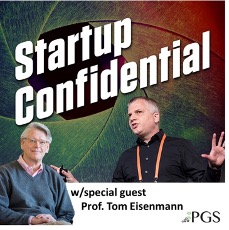Why Startups Fail – False Starts
Some of you may have already caught June’s 1st episode of Startup Confidential. For the rest of you, here’s an excerpt from my recent interview with Prof. Tom Eisenmenn, author of Why Startups Fail.
ME: “ One of the sources of False Starts you talk about is not doing really good pre-revenue market thinking. Boil down for us what you talk about in terms of what is worth researching in advance versus what’s worth waiting for the market to tell you about your thing.
TOM: So, let me isolate things you can learn in advance and things you can’t. The things you can learn in advance are something about unmet customer needs. We’ve got a dog walking service in the book, and if you’re going to launch a dog walking service, you better spend a lot of time talking to families about how they walk their dog, how their dog gets walked. How important is the trustworthiness of the stranger you’re letting into your apartment? How important is their knowledge of your pets’ peccadillos and in your family’s preferences, how important is flexibility? Both husband and wife are traveling, and you need somebody who can sort of flexibly do that dinner time walk and et cetera, et cetera, et cetera. You can learn a lot about it. And if the sort of dominant mode of pet care is just these independents who sort of manage to somehow attract a book of business, you can find out a lot about what doesn’t work and maybe about solutions that would better satisfy.
I don’t think there’s any question you can learn about unmet customer needs. When the needs are latent, and people can’t articulate them because the thing you have in mind is something you’ve never done before, that’s obviously tricky.
ME: You hire the anthropologist. Right, Tom?
TOM: So there’s a thing where you have trouble. The other two aspects of this. It’s not necessarily focused on the customer value proposition, the problem, and the solution. But a lot of businesses only work if you [i.e., your team] can execute them. As an example in the book, I have a couple of founders who launched an apparel company not too far from the world you live in because there’s inventory, and it’s a very physical thing. And it turns out that, and like, I think food and beverage, there are all sorts of specialty functions. There’s a pattern cutter, there’s a fabric sourcer, there’s quality. And all of these people have to do their thing in sequence, and it all has to mesh together. If you’re doing a startup with people who’ve never done it together before, and you don’t have the systems that are at an Ann Taylor, all hell can break loose. So, these poor entrepreneurs had validated, actually, the concept they had was young, professional women have a hard time finding stylish, affordable clothing that fits well. The emphasis being the last part. You can find any two of the three, but getting all three is a hard…..
ME: It sounds like Lulu lemon for the office.
TOM: Maybe, yeah. But anyway, so the secret sauce was a sizing scheme instead of size six or size 10, they were going to do it like men’s suiting where chest size and a sleeve length. And they’ve only compounded their execution challenges now by doing it; there’s a reason why women’s clothing isn’t made like that. It’s hard, and they’ve never done it before, and they hired a bunch of industry veterans who came out of places where, “I was a fabric sourcer, I don’t know anything about pattern cutting,” So they did the Jack of all trades behavior that you’d get in an early-stage startup. They just sat on their hands and said, “I don’t know how to do that. It’s not my job anyway.”
ME: So you can’t test in advance the ability to execute a complicated business. That can’t be done. The other thing you can’t do in advance, which I think is closer to where you’re probably going to go, is repurchase, right?
TOM: You can do all sorts of clever things to sort of get, figure out whether people will purchase, and you can put facsimile of the product in front of them. You can put the real product in front of them, but most businesses don’t work unless there’s a repurchase. And you just don’t know until you’ve seen it. And you’ve seen it enough times with enough people in the segments you’re interested in. So, shame on the entrepreneur who skips the part that I said you could do, which is isolated unmet customer needs, and you can explore different solutions for those needs. To get feedback from customers, again, if it’s a sufficiently familiar concept that they really are able.
